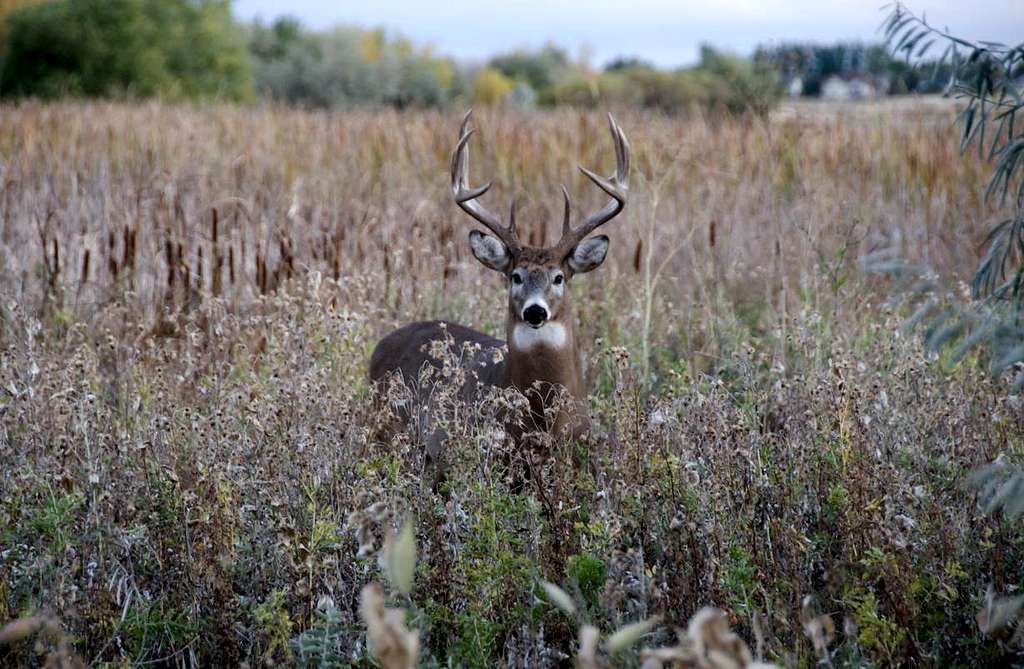
White-tailed deer are finding themselves in a rut these days. No, they aren’t locked in a boring, monotonous routine. More likely, they are locking horns. It’s the breeding season. Just like elk and mule deer, white-tailed deer are obsessed with self-perpetuation, the most powerful force in nature. For wildlife viewers, this is a good thing. There are increased opportunities to see these shy, secretive animals as the hormone-ravaged deer disregard their usual inhibitions and throw caution to the wind.
White-tails are the smallest members of the deer family in Colorado. They differ from the larger mule deer by having smaller ears and a broad tail with a white underside that they hold erect while they run. Males grow antlers with a single main beam that bears smaller tines. White-tailed deer are mostly active at dawn and dusk. Unlike mule deer, white-tails do not migrate seasonally.
White-tailed deer have never been common in Colorado. It is doubtful they were even in the state before European settlers moved west. Our eastern plains were virtually treeless in the 1800s and provided no habitat. As cottonwoods, willows, tamarisk and croplands began to flank the grassland rivers, white-tailed deer followed. While they are much more numerous now, they are difficult to find because they tend to be solitary and do not remain in open areas for long. They hug the edges of streamside woodlands, moving in the shadows to nearby croplands for food. They glide like phantoms among the cottonwoods and shrubs of the plains. The rut changes all of that.
Through the summer, bucks avoid each other as their new antlers develop, nourished by a cover of blood-rich velvet. In September, as the days shorten and the bucks’ testosterone levels rise, the antlers finish growing and the velvet starts drying up. That’s when rutting behavior begins. The bucks start clashing with each other—mostly short-lived shoving matches. The sparring helps establish dominance among males.
Bucks begin rubbing their antlers and the scent glands near their eyes on branches, shrubs and small trees. The scent marks the buck’s territory. Once created, a “rub” may be used by several bucks or even does.
Bucks begin making scrapes several weeks after the first rubs appear. They choose places to scrape by tracking trails and smelling for secretions from glands in the does’ hoofs. Once a suitable spot is found, the buck paws the ground, creating a circular-shaped depression. He urinates in the scrape and presses his front hoof in the middle of it. Just to be sure other bucks know this is his spot, the buck will break an overhanging branch by biting or pulling on it, then rub the branch with his scent glands and salivate all over it .
The bucks’ necks enlarge from the constant exercise of rubbing and high levels of hormones, further preparing them for battle. As the peak of the breeding season approaches, sparring matches give way to full-blown combat. Rather than gathering does into harems, males cluster around females, looking for does that are ready for mating. They fight to gain access to a particular female. Mating occurs from October to December. The peak of the rut for this species is early November. Look for scrapes on the ground where bucks have left their scent to mark territory. Unlike elk in rut, white-tailed deer are not especially vocal. Injured deer utter a startlingly loud "blatt" or bawl. Whistles or snorts of disturbed whitetails are the most commonly heard sounds.
Where to Look
From the Colorado Wildlife Viewing Guide, Second Edition Revised
Eastern Colorado, especially along the South Platte, Arkansas, and Republican rivers. Try Tamarack Ranch State Wildlife Area (Site #3), South Republican State Wildlife Area (Site #9), and Flagler Reservoir State Wildlife Area (Site #10).
To view white-tailed deer near Denver, visit South Platte Park (Site #57) or the Rocky Mountain Arsenal National Wildlife Refuge (Site #62).
In Fort Collins, head for the greenbelt (Site #33).
In the southeastern part of the state, south of Lamar near Springfield, try Two Buttes State Wildlife Area (Site #25) for some excellent deer viewing opportunities.







Comments
Post a Comment